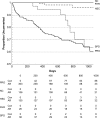Validity of the prodromal risk syndrome for first psychosis: findings from the North American Prodrome Longitudinal Study
- PMID: 19386578
- PMCID: PMC2728816
- DOI: 10.1093/schbul/sbp027
Validity of the prodromal risk syndrome for first psychosis: findings from the North American Prodrome Longitudinal Study
Abstract
Treatment and prevention studies over the past decade have enrolled patients believed to be at risk for future psychosis. These patients were considered at risk for psychosis by virtue of meeting research criteria derived from retrospective accounts of the psychosis prodrome. This study evaluated the diagnostic validity of the prospective "prodromal risk syndrome" construct. Patients assessed by the Structured Interview for Prodromal Syndromes as meeting criteria of prodromal syndromes (n = 377) from the North American Prodrome Longitudinal Study were compared with normal comparison (NC, n = 196), help-seeking comparison (HSC, n = 198), familial high-risk (FHR, n = 40), and schizotypal personality disorder (SPD, n = 49) groups. Comparisons were made on variables from cross-sectional demographic, symptom, functional, comorbid diagnostic, and family history domains of assessment as well as on follow-up outcome. Prodromal risk syndrome patients as a group were robustly distinguished from NC subjects across all domains and distinguished from HSC subjects and from FHR subjects on most measures in many of these domains. Adolescent and young adult SPD patients, while distinct from prodromal patients on definitional grounds, were similar to prodromals on multiple measures, consistent with SPD in young patients possibly being an independent risk syndrome for psychosis. The strong evidence of diagnostic validity for the prodromal risk syndrome for first psychosis raises the question of its evaluation for inclusion in Diagnostic and Statistical Manual of Mental Disorders (Fifth Edition).
Figures


Comment in
-
Anticipating DSM-V: should psychosis risk become a diagnostic class?Schizophr Bull. 2009 Sep;35(5):841-3. doi: 10.1093/schbul/sbp071. Epub 2009 Jul 24. Schizophr Bull. 2009. PMID: 19633215 Free PMC article. No abstract available.
References
-
- Gennaro AR, Gould GM. Blakiston's Gould Medical Dictionary. 4th ed. New York, NY: McGraw-Hill Book Company; 1979.
-
- Bleuler E. Dementia Praecox or the Group of the Schizophrenias. New York, NY: International Universities Press; 1911.
-
- Yung AR, McGorry PD, McFarlane CA, et al. Monitoring and care of young people at incipient risk of psychosis. Schizophr Bull. 1996;22:283–303. - PubMed
-
- Miller TJ, McGlashan TH, Rosen JL, et al. Prospective diagnosis of the initial prodrome for schizophrenia based on the Structured Interview for Prodromal Syndromes: preliminary evidence of interrater reliability and predictive validity. Am J Psychiatry. 2002;159:863–865. - PubMed
-
- Miller TJ, McGlashan TH, Rosen JL, et al. Prodromal assessment with the structured interview for prodromal syndromes and the Scale of Prodromal Symptoms: predictive validity, interrater reliability, and training to reliability. Schizophr Bull. 2003;29:703–715. - PubMed
Publication types
MeSH terms
Grants and funding
- R01 MH60720/MH/NIMH NIH HHS/United States
- R01 MH065562/MH/NIMH NIH HHS/United States
- R01 MH065079/MH/NIMH NIH HHS/United States
- UL1 TR000454/TR/NCATS NIH HHS/United States
- U01 MH066134/MH/NIMH NIH HHS/United States
- U01 MH066160/MH/NIMH NIH HHS/United States
- P50 MH080272/MH/NIMH NIH HHS/United States
- R01MH062066/MH/NIMH NIH HHS/United States
- R01 MH060720/MH/NIMH NIH HHS/United States
- K05MH01654/MH/NIMH NIH HHS/United States
- K24 MH76191/MH/NIMH NIH HHS/United States
- K23 MH001905/MH/NIMH NIH HHS/United States
- U01 MH066069/MH/NIMH NIH HHS/United States
- R21MH075027/MH/NIMH NIH HHS/United States
- P50 MH064065/MH/NIMH NIH HHS/United States
- K24 MH076191/MH/NIMH NIH HHS/United States
- R01 MH061523/MH/NIMH NIH HHS/United States
- U01 MH082004/MH/NIMH NIH HHS/United States
- U01 MH081944/MH/NIMH NIH HHS/United States
LinkOut - more resources
Full Text Sources
Medical
Molecular Biology Databases
Miscellaneous

